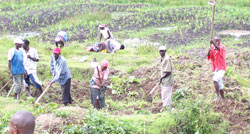The U.S. Agency for International Development has facilitated Kirehe District to establish a grain storage facility in an attempt to cut post harvest crop losses.The facility is equipped with modern drying, cleaning, weighing and storage equipment, which is set to increase the quality of harvest, USAID said in a press statement.


The U.S. Agency for International Development has facilitated Kirehe District to establish a grain storage facility in an attempt to cut post harvest crop losses.
The facility is equipped with modern drying, cleaning, weighing and storage equipment, which is set to increase the quality of harvest, USAID said in a press statement.
"This in turn will help producers with surpluses to compete in domestic and regional markets,” the statement reads in part.
The facility will boost government’s initiative to improve post-harvest storage facilities especially in rural areas as it attempts to increase farmers’ margins and improve food security by minimising post harvest losses.
Statistics indicate that post harvest losses incurred by farmers stand at 40 per cent of the crops harvested. The losses are attributed to pests, moulds and other factors which affect crops that are stored for more than one week.
The facility was constructed under a public private partnership arrangement with Nkubili Alfred and Sons (ENAS), a private player securing a grant worth US$105,952 (Rwf63.9m) from USAID.
With a capacity to store 8,000 metric tons, the facility is expected to benefit some 18,000 farmers, mostly smallholder maize farmers, who are currently forced to sell their produce prematurely because they lack adequate storage.
Trade and Industry Minister, Francois Kanimba, hailed the facility, saying that it serves as one of his mandates to provide markets to farmers and increasing production.
Brian Frantz, USAID General Development Officer emphasised that the project proves that the private sector can be convinced to invest in storage infrastructure, even for staple crops like beans and maize, a move that helps government to achieve its goal of reducing post-harvest losses.
In a similar move aimed at reducing losses and boost the bargaining power of farmers, government is in the process establishing a 20,000 metric tone strategic grain reserve at the Nyandungu-based Kigali Economic Zone.
A 10,000 and 15,000 metric tonnes strategic reserves are set to be completed in Nyagatare and Kirehe districts, respectively.
Ends


